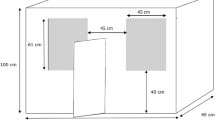Abstract
Common in any population of thoroughbred racehorses are stereotypic stress-related behaviors such as stall-walking and weaving. These syndromes are debilitative and prevent the animal from running to its true potential. Use of chemical tranquilizers are neither very effective nor permissible under many state racing laws, and presence of companion animals only occasionally alleviates the condition. Use of high-voltage electrostatic fields has, however, been shown to alleviate the problem by 80% or more in up to 95% of the xases. This is expected to improve when reliability problems with high-voltage power supplies are resolved. The electric field created by a wire grid suspended over the animal is believed to replace the natural one shielded out by the barn, and to induce a minute electrical current through the animal. Improvement in behavior is usually seen in 24–72 hr, but does not persist if the treatment is stopped or electrical noise interferes. The horse's sensitivity to this noise may provide clues to why animals get nervous before earthquakes.
Similar content being viewed by others
References
Lott, J. R. and McCain, H. B. 1973.Int. J. Biometeorol. 17, 221–225.
Mayyasi, A. M. and Terry, R. A. 1969.Int. J. Biometeorol, 13, 101–111.
Daniel, K. W. O. 1958.Erfahrungsheilkunde 7, 576–81.
Daniel, K. W. O. 1965a.Erfahrungsheilkunde, 119–23.
Daniel, K. W. O. 1965b.Erfahrungsheilkunde, 491–92.
Jones, F. C. 1974. The effects of a positive electric field on the behavior of emotionally disturbed children. Ph.D. Dissertation, Univ. of Kansas, Diss. Abstr. Int., 1975, 35.
Krueger, A. P. and Reed, E. J. 1976.Science 193, 1209–1213.
Krueger, A. P., Kotaka, S., and Andriese, P. C., 1962.Int. J. Biometeor. 6, 33–48.
Pilla, A. A., Sechaud, P., and MeLeod, P. R. 1983.J. Biol. Phys. 11, 51–58.
Pohl, H. A. 1978.J. Biol. Phys. 5, 3–23.
Pohl, H. A. and Todd, G. W. 1081.Int. J. Biometeor 25, 309–321.
Sale, A. J. H., and Hamilton, W. A. 1967.Biochim. Biophys. Acta 148, 781–788; 789–800.
Author information
Authors and Affiliations
Rights and permissions
About this article
Cite this article
Smith, L.B. Electric field therapy for equine sterotypic behaviors. J Biol Phys 12, 33–36 (1984). https://doi.org/10.1007/BF01857656
Issue Date:
DOI: https://doi.org/10.1007/BF01857656




